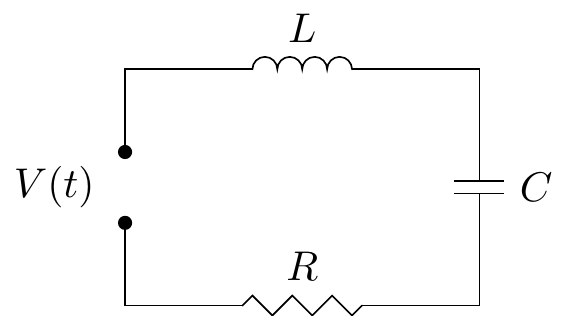Topic 6 - Differential equations
Week 18 Material
Question 6.1 \(\;\) Find the general solution of each of the following separable equations:
\(\;(a)\;\;\dfrac{dy}{dx}=\dfrac{y}{x},\hspace{2.9cm}\) \(\;(b)\;\;\dfrac{dy}{dx}=x^3y^3,\hspace{2.5cm}\) \(\;(c)\;\;\dfrac{dy}{dx}=1+y^2\),
\(\;(d)\;\;\dfrac{dy}{dx}=\dfrac{5x+7}{3y+2},\hspace{1.8cm}\) \(\;(e)\;\;\dfrac{dy}{dx}=\dfrac{3y+2}{5x+7},\hspace{1.85cm}\) \(\;(f)\;\;\dfrac{dy}{dx}=\dfrac{1+y^2}{1+x^2},\)
\(\;(g)\;\;x\dfrac{dy}{dx}=y-xy,\hspace{1.8cm}\) \(\;(h)\;\;\dfrac{dy}{dx}=1+x+y+xy.\)
Question 6.2 \(\;\) Solve the following separable equations with given initial conditions:
\(\;(a)\;\;(x^2+1)y\dfrac{dy}{dx}=1\;\;\) where \(y(0)=-3,\hspace{0.75cm}\) \(\;(b)\;\;\dfrac{dy}{dx}=3x^2e^{-y}\;\;\) where \(y(-1)=0\),
\(\;(c)\;\;\dfrac{dy}{dx}=\sec y\;\;\) where \(y(0)=0,\hspace{2.35cm}\) \(\;(d)^*\;\;\dfrac{dy}{dx}=y^2\sin x\;\;\) where \(y(\pi)=-1/5\).
Question 6.3 \(\;\) A wet porous substance in the open air loses its moisture at a rate proportional to the moisture content. If a sheet hung in the wind loses half its moisture during the first hour, when will it have lost 99%, assuming weather conditions remaining the same?
Question 6.4 \(\;\) A hemispherical water tank of radius \(R\) metres is filled with water which leaks through a circular hole of radius \(r\) metres at the bottom. Torricelli’s law shows that if \(h(t)\) is the depth of water in metres left in the tank after \(t\) seconds, then \(h(t)\) satisfies the differential equation \[\pi(2hR-h^2)\frac{dh}{dt}=-\pi r^2\sqrt{2gh}\] where \(g\) is the acceleration due to gravity. Calculate the time the bowl takes to empty.
Question 6.5 \(\;\) A common model for population growth is the logistic equation: \[\frac{dy}{dt}=ry(1-y/K)\] where \(r\) and \(K\) are positive constants. By separating variables, show that \[y(t)=\frac{Ky_0e^{rt}}{K+y_0(e^{rt}-1)}\] where \(y_0=y(0)\) is the initial population. (You may assume that \(y(t)\) always satisfies \(0\leq y(t)<K\).)
Question 6.6 \(\;\) Find the general solution of the following homogeneous equations:
\(\;(a)\;\;\dfrac{dy}{dx}=\dfrac{y}{x}+\left(\dfrac{y}{x}\right)^2,\hspace{2cm}\) \(\;(b)\;\;2\dfrac{dy}{dx}=\left(\dfrac{x+y}{x}\right)^2,\)
\(\;(c)^*\;\;\dfrac{dy}{dx}=\dfrac{y^2-x^2}{xy},\hspace{2.65cm}\) \(\;(d)\;\;\dfrac{dy}{dx}=\dfrac{y^2-2xy}{x^2-2xy}.\)
Question 6.7 \(\;\) Find the general solution of the following linear equations:
\(\;(a)\;\;\dfrac{dy}{dx}+\dfrac{y}{x}=x^2,\hspace{2.5cm}\) \(\;(b)\;\;\dfrac{dy}{dx}+y\cot x=2\cos x,\)
\(\;(c)\;\;\dfrac{dy}{dx}+2y=e^x,\hspace{2.55cm}\) \(\;(d)\;\;x\dfrac{dy}{dx}=y+x^3.\)
Question 6.8 \(\;\) Solve the following linear equations with initial conditions:
\(\;(a)\;\;y'-y\tan x=\sec x\;\;\) where \(y(0)=1,\hspace{1cm}\) \(\;(b)^*\;\;xy'+y-e^x=0\;\;\) where \(y(2)=1\).
Question 6.9 \(\;\) The circuit pictured is a condenser consisting of a voltage source \(V\) volts, a capacitor \(C\) farads and two resistors \(R\) and \(S\) ohms.

The charge \(Q(t)\) at time \(t\) in the circuit is known to satisfy an ODE \[RSC\frac{dQ}{dt}+(R+S)Q=SCV.\] Find a formula for \(Q(t)\) given that \(Q(0)=0\) coulombs, \(R=5\) ohms, \(S=10\) ohms, \(C=10^{-3}\) farads and \(V=30\) volts.
Question 6.10 \(\;\) Find the general solution of the following Bernoulli equations:
\(\;(a)\;\;\dfrac{dy}{dx}+\dfrac{y}{x}=xy^2\sin x,\hspace{1cm}\) \(\;(b)\;\;2x\dfrac{dy}{dx}-y=10x^3y^5,\hspace{1cm}\) \(\;(c)\;\;\dfrac{dy}{dx}-xy=-e^{-x^2}y^3.\)
Question 6.11 \(\;\) Check that the following ODEs are exact and solve them.
\(\;(a)\;\;\left( x^3+2y\right) \dfrac{dy}{dx}+3x^2y+1=0,\hspace{1cm}\) \(\;(b)\;\;2y\left( x^4+1\right) \dfrac{dy}{dx}+4x^3y^2-2x-1=0,\)
\(\;(c)^*\;\;\left(x^3\cos y\right)\dfrac{dy}{dx}+3x^2\sin y+1=0,\hspace{0.4cm}\) \(\;(d)\;\;\left( x^2\sec^2 y+1\right) \dfrac{dy}{dx}+2x\tan y-\sin x=0.\)
Question 6.12 \(\;\) Determine if the following differential equations are exact and solve those which are:
\(\;(a)\;\;(1+x^3)\dfrac{dy}{dx}+3x^2y+1=0,\hspace{1cm}\) \(\;(b)\;\;y+(1+y)\dfrac{dy}{dx}=0,\hspace{1cm}\) \(\;(c)\;e^{2x}\dfrac{dy}{dx}+2e^{2x}y=0,\)
\(\;(d)\;\;(5y-2x)\dfrac{dy}{dx}=x+2y,\hspace{1cm}\) \(\;(e)\;\;e^{2x}\dfrac{dy}{dx}+2e^{2x}y+1=0.\)
Question 6.13 \(\;\) Solve the following mixed bag of equations.
\(\;(a)\;\;\dfrac{dy}{dx}=(e^xy)^2-y,\hspace{1cm}\) \(\;(b)\;\;\dfrac{dy}{dx}=y^2-5y+6,\hspace{1cm}\) \(\;(c)\;\;2\dfrac{dy}{dx}=\dfrac{y}{x}+\dfrac{y^2}{x^2},\hspace{1.1cm}\)
\(\;(d)\;\;\dfrac{dy}{dx}=\dfrac{1+\sin y}{\cos y},\hspace{1cm}\) \(\;(e)\;\;x^2\dfrac{dy}{dx}=y(x+y)\;\;\) given that \(y(1)=-1,\)
\(\;(f)\;\;e^{-x}\cos x\dfrac{dy}{dx}-ye^{-x}\sin x=x\;\;\) given that \(y(0)=0,\hspace{1cm}\)
\(\;(g)\;\;x(x-1)\dfrac{dy}{dx}+y=x^2e^{-x}.\)
Week 19 Material
Question 6.14 \(\;\) Find the general solution of each of the following:
\(\;(a)\;\;y''+2y'-15y=0,\hspace{2.9cm}\) \(\;(b)\;\;2y''+3y'-2y=0,\)
\(\;(c)\;\;y''-6y'+25y=0,\hspace{2.9cm}\) \(\;(d)\;\;y''+6y'+9y=0,\)
\(\;(e)\;\;3y''+5y'-2y=0,\hspace{2.9cm}\) \(\;(f)\;\;4y''+y=0.\)
Question 6.15 \(\;\) Solve the following homogeneous second order linear differential equations:
\(\;(a)\;\;y''-5y'-6y=0\;\;\) with initial conditions \(\;\;y(0)=5\), \(y'(0)=12\).
\(\;(b)\;\;3y''-8y'-3y=0\;\;\) with initial conditions \(\;\;y(0)=2\), \(y'(0)=-4\).
\(\;(c)\;\;y''+2y'+5y=0\;\;\) with initial conditions \(\;\;y(0)=1\), \(y'(0)=-3\).
\(\;(d)\;\;y''-4y'+29y=0\;\;\) with initial conditions \(\;\;y(0)=2\), \(y'(0)=-1\).
\(\;(e)\;\;y''+2y'+y=0\;\;\) with initial conditions \(\;\;y(0)=1\), \(y'(0)=2\).
\(\;(f)\;\;y''-6y'+9y=0\;\;\) with initial conditions \(\;\;y(0)=2\), \(y'(0)=7\).
\(\;(g)\;\;y''-2y'+2y=0\;\;\) with conditions \(\;\;y(0)=3\), \(y(\pi/2)=0\).
(In \((g)\), instead of giving initial values for \(y\) and \(y'\), we have given two values for \(y\) at different points - these are sometimes called boundary values.)
Question 6.16 \(\;\) Find the general solution of each of the following:
\(\;(a)\;\;y''+y'-2y=2e^{-x},\hspace{2.6cm}\) \(\;(b)^*\;\;y''+y'-2y=e^x,\)
\(\;(c)\;\;y''+y'-6y=52\cos 2x,\hspace{1.75cm}\) \(\;(d)\;\;2y''+3y'-2y=\sin x,\)
\(\;(e)\;\;y''+y=2\sin x,\hspace{3.5cm}\) \(\;(f)\;\;y''-2y'+2y=e^x\cos x.\)
Question 6.17 \(\;\) Find complementary functions and particular integrals for the following:
\(\;(a)\;\;y''+2y'-3y=4e^{-x}+26e^{2x}\cos{x},\hspace{1cm}\) \(\;(b)\;\;y''+4y'+4y=32e^{2x}-2e^{-2x}.\)
Question 6.18 \(\;\) Solve the following inhomogeneous second order linear differential equations:
\(\;(a)\;\;y''-4y'+3y=3x^2-5x+1\;\;\) with initial conditions \(y(0)=4\), \(y'(0)=8\).
\(\;(b)\;\;y''-y'-2y=3e^{2x}\;\;\) with initial conditions \(y(0)=0\), \(y'(0)=-2\).
\(\;(c)\;\;y''-4y'+5y=9\cos(2x)+7\sin(2x)\;\;\) with initial conditions \(y(0)=0\), \(y'(0)=0\).
\(\;(d)\;\;y''+4y=-8\sin(2x)\;\;\) with initial conditions \(y(0)=2\), \(y'(0)=2\).
\(\;(e)\;\;y''+4y'+4y=e^{-x}\;\;\) with initial conditions \(y(0)=2\), \(y'(0)=0\).
\(\;(f)\;\;y''-2y'+y=xe^x \;\;\) with initial conditions \(y(0)=-2\), \(y'(0)=-1\).
Week 20 Material
Question 6.19 \(\;\;\) Let \(y(t)\) be the displacement at time \(t\) of the mass in a critically damped oscillator with damping constant \(c\) and mass \(m=1\). If \(y(0)=0\) and \(y'(0)=v_0\), show that the mass will come to rest when \(y=2v_0/ce\).
Question 6.20 \(\;\) The differential equation for the current \(I(t)\) in a series LCR circuit is \[L\dfrac{d^2I}{dt^2}+R\dfrac{dI}{dt}+\dfrac{I}{C}=\dfrac{dV}{dt}.\]

Find the current in the following cases, assuming that \(I(0)=I'(0)=0\).
\(\;(a)\;\;\) \(R=20\), \(L=10\), \(C=0.05\) and \(V(t)=50\sin t\).
\(\;(b)\;\;\) \(R=240\), \(L=40\), \(C=10^{-3}\) and \(V(t)=369\sin(10t)\).
Question 6.21 \(\;\) In an LCR circuit without a capacitor, the differential equation is first order \[L\frac{dI}{dt}+RI(t)=V(t).\] Solve this equation in the cases \(\;(a)\;\;V(t)=V_0\) is constant, \(\hspace{0.3cm}\) \(\;(b)\;\;V(t)=V_0\sin(\omega t)\).
Comment on the long term behaviour of the current \(I(t)\) in each case.
Question 6.22 \(\;\) A cylindrical buoy 60 cms in diameter and weight \(m\) grams floats in water with its axis vertical. When depressed slightly and released, it is found that the period of oscillation is 2 seconds. Archimedes’ principle shows that if \(x(t)\) is the length of the cylinder immersed at time \(t\) then \(x(t)\) satisfies the equation \(x''+ax=g\), where \(a=900\pi g/m\) and \(g=981\). Calculate the weight of the buoy and the depth of the bottom of the buoy below the waterline when the buoy is in the equilibrium position.
Question 6.23 \(\;\) Solve the following systems of differential equations:
\(\;(a)^*\;\;\left\{\begin{aligned} \dot{x} &= -10x+18y \\ \dot{y}&=-6x+11y \end{aligned}\right.\hspace{2.8cm}\) \(\;(b)\;\;\left\{\begin{aligned} \dot{x} &= 3x+4y \\ \dot{y}&=3x+2y \\ &\text{where $x(0)=6$, $y(0)=1$} \end{aligned}\right.\)
\(\;(c)\;\;\left\{\begin{aligned} \dot{x} &= -x+2y \\ \dot{y}&=2x-y \\ &\text{where $x(0)=3$, $y(0)=1$} \end{aligned}\right.\hspace{0.8cm}\) \(\;(d)\;\;\left\{\begin{aligned} \dot{x} &= 2x-2y-z \\ \dot{y}&=5x-3y+z \\ \dot{z}&=-4x+2y-z \end{aligned}\right.\)
\(\;(e)\;\;\left\{\begin{aligned} \dot{x} &= 5x+3z \\ \dot{y}&=9x+2y+9z \\ \dot{z}&=-6x-4z \end{aligned}\right.\hspace{2.6cm}\) \(\;(f)\;\;\left\{\begin{aligned} \dot{x} &= x+2z \\ \dot{y}&=y-z \\ \dot{z}&=x+y+z \\ &\text{where $x(0)=y(0)=1$, $z(0)=4$} \end{aligned}\right.\)